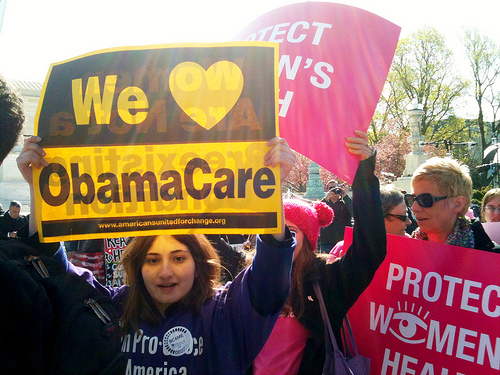How Republicans keep making the argument for single-payer

The White House announced on Thursday that six million people had picked a health insurance plan through an Obamacare exchange and Republicans said all at once, as they’ve been training each other to do, “BUT HOW MANY PEOPLE HAVE PAID?”
“How many people have paid?” is a great argument against Obamacare, if your alternative were single-payer, where paying isn’t optional and everyone gets covered.
Single-payer is a fine alternative to Obamacare because we know it works! See: Medicare, which consistently controls costs better than our private health care providers. See also: the rest of the industrialized world, which covers far more of the population than far less than we spend.
As an alternative to single-payer, Obamacare will make a huge dent in the uninsured population but it won’t cover everyone. It wasn’t designed to because it’s made up of compromises on top of compromises, as The New Republic’s Jonathan Cohn often points out.
The Republican alternatives, the sketches of these mythical beasts that exist, will cover far fewer people than Obamacare with far fewer benefits. And since the right’s plan likely won’t be single-payer, it will also require people to pay, which about 20 percent won’t, because paying for things is much harder than having the cost just deducted from your paycheck. (And if Republicans wanted more people covered without them having to pay, they could simply expand Medicaid to the five million working people they’re denying coverage by turning down the expansion their state is paying for anyway.)
So critics of Obamacare have a point when they say six million enrollments won’t end up being six million enrollments. But there’s a far greater chance that we’re under-counting than over-counting.
The genius of Charles Gaba’s ACASignups.net is that he attempts to quantify the success of Obamacare by giving a fairer sense of the law’s winners than we’ve been seeing in the media.
He counts the paid enrollments in the echanges that most people are fixated on. He also is tracking Medicaid signups, assiduously trying to determine how many are new, how many are the direct result of expansion, how many are “woodworkers” who are just signing up now because the publicity. And he gives the law credit for people up to age 26 who are covered under their parents’ plan thanks to Obamacare.
Charles also notes that the off-exchange enrollments are even harder to track than the jumbled state numbers he’s been sorting through. He estimates that as many as four million Americans have gained coverage through that method.
As of Friday afternoon, Charles found that at least 12.6 million and as many as 16.2 million Americans have gained coverage thanks to the law. This number will vary! It will go up a lot as the deadline nears and the people still in line have a chance to enroll in the next month. It will go down when some people don’t pay. And it will go up as Medicaid enrollment continues and expansion begins in new states, including Michigan.
The resulting number — somewhere around 18 million, I’d guess — will still only be a fraction of the uninsured population. But one of the greatest fictions about the law is that it only helps the uninsured.
It also is crucial for the underinsured, people who thought they had enough coverage — until they got sick. A new Commonwealth Fund study finds that nearly 32 million Americans were “insured but underinsured” before the ACA, meaning they spent “a high-share of their income” on health care.
Obamacare both caps the amount the insured can be asked to spend in one year and removes the lifetime caps that insurers used to put on their policies. It adds free preventative care for everyone who is covered, while expanding mental health care and substance abuse treatment.
And, most importantly, it provides crucial stability to tend of millions of workers, many of whom have been entirely dependent on their employers for their family’s health coverage.
“They now are in a situation where if they lose their job or decide to quit they will still be able to get insurance,” explains Dean Baker, the co-director of the Center for Economic and Policy Research. “That was not previously true, especially if a worker or someone in their family has a serious medical condition.”
So with all these winners, why is the law so unpopular? Hundreds of millions of dollars spent to misrepresent the law hasn’t helped. The least popular parts of the law are the best known and the lies about it manage to stick like a bad pre-existing condition.
The New Yorker‘s John Cassidy looked at a recent Kaiser Foundation poll and noted, “It suggests that one in three Americans believe that the A.C.A. established a ‘death panel’ to make decisions about the end-of-life coverage that people receive under Medicare, and another one in four Americans aren’t sure whether such a panel exists. (It doesn’t.)”
There’s a real conspiracy to scare people about the law. And there is a real obliviousness of the number of people the law is helping because — like the largest tax cut for the middle class in history buried in the Stimulus — some of the new benefits are quietly baked in to your policy.
But the number of people the law is helping isn’t six million or the four-point-something million of that six million who will pay.
Obamacare has helped at least 12 million Americans get covered while improving coverage for tens of millions more. And if Republicans aren’t satisfied with that number, I can’t wait to see their plan that would do better.
[LaDawna Howard | Flickr]



